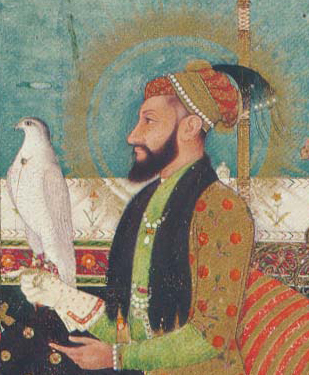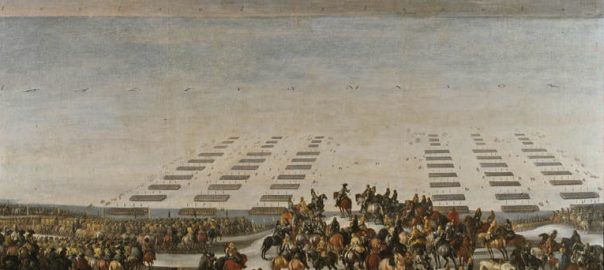In 1658 CE there were major political transitions in both England and the Mughal Empire, so those will form the meat of today’s bulletin. The year’s other main empire news came from the young Dutch settler colony at South Africa’s Cape of Good Hope, where 1658 saw the first importation of enslaved people, and from Sweden, which managed a significant amphibious breakout into Denmark and potentially onto the Atlantic coast.
I’ll spend just a short time summarizing what was happening with Sweden, then move to the Mughal Empire, then England.
Sweden’s breakout toward the ocean
The earlier Swedish king, Gustavus Adolphus, had been an ambitious man whose military campaign across the Baltic into northern Germany had been decisive in ending the Thirty Years War in 1648. But he had always been prevented by his foe Denmark from getting the kind of direct access to the Atlantic Ocean that any ambitious European power needed if it wanted to build a transoceanic empire. (His little attempt at creating a “New Sweden” colony in the Delaware Valley had been puny, and had anyway fallen to the Dutch of “New Netherlands” a few years prior.)
Gustavus Adolphus’s nephew, known as Charles X Gustav, had been king since 1654 and had been waging numerous wars against Sweden’s Baltic neighbors. One of these was against Denmark, which controlled all of present-day Norway. Crucially, Denmark controlled the island-strewn straits through which any Swedish expeditions to and across the Atlantic would have to travel (as well as blocking Sweden from any direct land route westward to the North Sea/ Atlantic.)
In January, Charles X’s generals saw that the two crucial straits at the mouth of the Baltic, known as the “Great Belt” and “Little Belt” were icing over and may soon be traversable by land forces. And in late January, that was indeed what happened. (You can read a detailed account of the “March across the Belts” here.)
So the Danes were taken completely by surprise and their king, Frederick III, had to speedily accept a humiliating peace settlement in order to avert total annihilation of his kingdom. This was done with the Treaty of Roskilde, concluded at the end of February, in which had to cede great chunks of Denmark/Norway to Sweden.
Actually, Charles X wasn’t satisfied with that and in July tried to invade Copenhagen itself. But Fred was able to call on the Dutch under a mutual support treaty and beat Charles X back to the agreed lines. (Also, a couple of years later, the residents of the two provinces of Norway that Fred had ceded to Charles X rose up against Swedish rule and threw the Swedes out.)
None of this, by the way, enabled Sweden to fulfill Gustavus Adolphus’s long-ago dream of making his country into a competitive world-imperial power.
The banner image above is another painting of the March Across the Belts. (The squares there are infantry formations.)
Mughal Emperor Shah Jahan falls sick, is elbowed aside
In the Mughal capital, Agra, Shah Jahan had been emperor since 1628. English-WP tells us this about his achievements:
During his reign the Marwari horse was introduced, becoming Shah Jahan’s favorite, and various Mughal cannons were mass-produced in the Jaigarh Fort. Under his rule, the empire became a huge military machine and the nobles and their contingents multiplied almost fourfold, as did the demands for more revenue from their citizens. But due to his measures in the financial and commercial fields, it was a period of general stability—the administration was centralized and court affairs systematized.
The Mughal Empire continued to expand moderately during his reign as his sons commanded large armies on different fronts. India at the time was a rich center of the arts, crafts and architecture, and some of the best of the architects, artisans, craftsmen, painters and writers of the world resided in Shah Jahan’s empire. According to economist Angus Maddison, Mughal-era India’s share of global gross domestic product (GDP) grew from 22.7% in 1600 to 24.4% in 1700, surpassing China to become the world’s largest…
Worth noting there that China had been wracked with civil conflict and civil disturbances in those years. But also worth noting that, as the leader of a massive land-based empire containing several distinct large (and often mutually competitive) religious segments and a plethora of different language groups, Emperor Shah Jahan had held things together pretty well though oftentimes by acting very brutally. He had also dealt very smartly with the armed Portuguese trading missions that in 1628 were still located almost completely around the coast of India, and with their English and Dutch counterparts who enlarged their presence along the coasts in those decades.
In 1658, now in his late 60s, he fell sick and his power faded speedily. WP tells us what happened:

When Shah Jahan became ill in 1658, Dara Shikoh (Mumtaz Mahal’s eldest son) assumed the role of regent in his father’s stead, which swiftly incurred the animosity of his brothers. Upon learning of his assumption of the regency, his younger brothers, Shuja, Viceroy of Bengal, and Murad Baksh, Viceroy of Gujarat, declared their independence and marched upon Agra in order to claim their riches. Aurangzeb, the third son, gathered a well-trained army and became its chief commander. He faced Dara’s army near Agra and defeated him during the Battle of Samugarh. Although Shah Jahan fully recovered from his illness, Aurangzeb declared him incompetent to rule and put him under house arrest in Agra Fort.
Jahanara Begum Sahib, Mumtaz Mahal’s first daughter, voluntarily shared his 8-year confinement and nursed him in his dotage. In January 1666, Shah Jahan fell ill… After reciting the Kal’ma (Laa ilaaha ill allah) and verses from the Quran, Shah Jahan died, aged 74…
Princess Jahanara had planned a state funeral which was to include a procession with Shah Jahan’s body carried by eminent nobles followed by the notable citizens of Agra and officials scattering coins for the poor and needy. Aurangzeb refused to accommodate such ostentation. The body was taken to the Taj Mahal and was interred there next to the body of his beloved wife Mumtaz Mahal.
Let’s see where Aurangzeb will take the empire over the years ahead…
After Anglo-French victory Cromwell dies, leaves England in political turmoil
In June 1658, the Anglo-French joint force assembled as a result of 1657’s Treaty of Paris, had a strong victory over the Spanish-Netherlands armies in the “Battle of the Dunes”, fought on the sandy flats around Dunkirk. Per the agreement they had reached in Paris, France would take ownership of Gravelines and England of Dunkirk and Mardyck. The English were particularly happy to oust the Spanish from these ports, as the Spanish had been using them for many decades as havens for the privateers harrassing English shipping in the English Channel
Through 1657 and the early months of 1658, throughout Cromwell had been acting in an increasingly imperial fashion. In late summer 1658, per English-WP, this happened:
he was struck by a sudden bout of malarial fever, followed directly by illness symptomatic of a urinary or kidney complaint… The decline may have been hastened by the death of his daughter Elizabeth Claypole in August. He died at age 59 at Whitehall on Friday 3 September 1658, the anniversary of his great victories at Dunbar and Worcester. The most likely cause was septicaemia (blood poisoning) following his urinary infection. He was buried with great ceremony, with an elaborate funeral at Westminster Abbey based on that of James I, his daughter Elizabeth also being buried there.
He was succeeded by his son Richard. How did that happen, you may ask? Well, on the WP page on Richard Cromwell it says this:
Oliver Cromwell died on 3 September 1658, and Richard was informed on the same day that he was to succeed him. Some controversy surrounds the succession. A letter by John Thurloe suggests that Cromwell nominated his son orally on 30 August, but other theories claim either that he nominated no successor, or that he put forward Charles Fleetwood, his son-in-law.
John Thurloe, you may recall, was Oliver’s spymaster. So maybe he had orchestrated the succession?
The main Oliver Cromwell page on WP tells that this happened after Oliver’s death:
Richard had no power base in Parliament or the Army and was forced to resign in May 1659, ending the Protectorate. There was no clear leadership from the various factions that jostled for power during the reinstated Commonwealth, so George Monck was able to march on London at the head of New Model Army regiments and restore the Long Parliament. Under Monck’s watchful eye, the necessary constitutional adjustments were made so that Charles II could be invited back from exile in 1660 to be King under a restored monarchy.
George Monck, who later became the 1st Duke of Albemarle, was a wily character. who had long been a key leader in the New Model Army and had been Governor of Scotland for some years by then. (See his signature on the notice above.) During the 20 months of deep uncertainty that followed Cromwell’s death, he continued to profess his loyalty to parliament and was ruthless in his suppression of Royalist tendencies among some other officers. During 1659 the military-controlled Council of State made two more attempts to convene a parliament that could gather the legitimacy needed to ensure the continuity of the form of non-monarchical rule that Oliver Cromwell had instituted. But both of those efforts failed, and Monck was making his way slowly back to London meantime. You’ll have to wait till 1660 to see how he engineered the kingly comeback that year.







